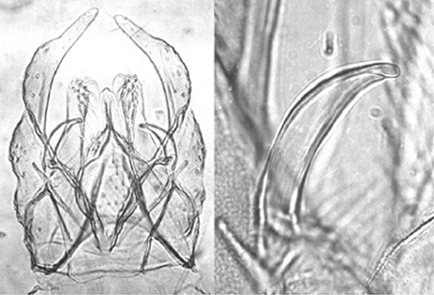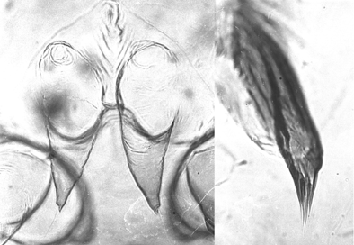Species c. C. decorus groupAdult:
Male: The adult male is a typical member of the C. decorus-group.

Male terminalia of C. species c.
A typical C. decorus-type hypopygium.About 13 setae in multiple associated pale patches on TIX, Superior volsella of E-type closest to Strenzke's figure g, i.e. longer than most decorus-group species. Anal point relatively broad with approximately parallel sides. Inferior volsella slightly longer than the anal point and to about the mid-point of the gonostylus which narrows markedly over the distal third. Female: No information available. Pupa: The pupa has small frontal warts (see figure below) on the frontal apotome but smaller than those found in C. decorus itself; cephalic tubercles about 1.9 times longer than width at base. Caudolateral spur on segment VIII has about 4-5 closely appressed spines. About 65 taeniae on anal fringe.  Fourth instar larva of the semireductus-type with moderately long tubules (abt 1.2 times segment width, on average of equal length (anterior 1.26 (0.71-1.84) mm; posterior 1.22 (0.62-1.84 mm). Larval length, females 12.59 (9.0-15.0); males 11.9 (9.5-12.3) mm. Lateral tubules relatively short, 152 (31-250) micron). Anal tubules about 3-6.6 times longer than wide, dorsal pair usually slightly longer (mean 448.5 cf. 397.8) and with a constriction about a third from the base. Salivary reservoir (Fig. a) about 68.3 (61-76) µm wide and 4.3 times longer than wide. Distance between antennal bases (159 (129-185) µm) generally slightly less than that between the S4 setae (161.2 (129-190) µm). Gular region darkened over most of central region, wider than the mentum and widest about a third up from Post occipital border, Frontoclypeus pale. S5 seta about level with nearby RO.
Mentum (Fig. c) with pointed teeth when not worn, c2 teeth only partly separated from the square sided c1 tooth (type IB or sometimes approaching III); 4th laterals partly reduced, about to level of 5th laterals (type I-II); width about 0.55-0.69 of Ventral head length.
Ventromental plates (Fig. d) about 209.2 (197-212.5) µm wide and 3.26-3.82 times wider than deep and 1.06-1.08 times the mentum width; with about 36.2 (30-43) striae; Interplate distance abt. 58-83 µm (0.29-0.38 of mentum width); VMR about 0.20-0.29. Pecten epipharyngis (Fig. a) with 13.4 (11-16) sharp pointed teeth (type A).
Premandible with narrow teeth coming to narrow points (ty. A), outer tooth about 2.5-4.2 times wider than inner tooth.
Distance between the antennal bases on average (155 (129-175) µm), about the same as that between the S4 setae (157.3(129-177) µm).
Antenna (Fig. b) with basal segment 0.36-0.39 of Ventral head length; AR abt. 2.07 (1.98-2.31); basal segment about 2.9-3.5 times longer than wide; A4/A3 about 1.85 (1.5-2.5), i.e. A3 relatively short (see fig. b); relative lengths antennal segments (micron) 122 : 25 : 7.5 : 13 : 6.5.
Mandible (Fig. e) with the third inner tooth slightly colored and not separated (type IA or B) and about 16.6 (14-20) furrows on outer surface near base; pecten mandibularis with about 11.4 (10-13) taeniae; Mdt-Mat about 35.7 (30-39) µm, MTR 0.45 (0.43-0.47). Cytology: 4 polytene chromosomes with thummi arm combination AB, CD, EF, G, these arm combinations difficult to identify.
Arm G normally paired nucleolus; Balbiani rings present but often difficult to see. No other nucleoli?
Bands 22-24 of arm B in usual position next to the centromere.
Quite polymorphic, including in arms A, B, D and F, and sometimes with complex inversions:
Arm A- a simple terminal inversion; arms B and F complex inversion; arm D simple inversion of mid-arm; arm E simple inversion. Arm G usually unpaired in the terminal region including the nucleolus.
The inv4-11b in arm E suggests a connection to C. quinnitukqut
Arm A1: distal end similar to that of C. harpi
Arm B1:
Arm C1:
Arm D1:
Arm E1: 1 - 3a, 5 - 10b, 11b - 10c, 3f - 4, 11c - 13
The inv4-11b in arm E suggests a connection to C. quinnitukqut.
Arm E2: approx 1 - 3a, 5 – 6, 10c – 11b, 10b – 7, 11c - 13Arm F1: Farm pools and pools in rivers. Found: Ontario – Copanspin Farm, Dunrobin (45.45°N, 76.00°W); Carlingwood, Ottawa (45.37°N, 76.00°W); Rideau River and Black Rapids (45.32°N, 75.82°W)
(all Carleton Co.); Vittoria, Norfolk Co.
Florida – Lake Ruby, Winter Haven.
Vermont – White River, Sharon (43.80°N, 72.45°W), Windsor Co. See also C. blaylocki, C. bifurcatus, C. sp. b, C. sp. j, C. sp. 2a, C. 'proulxi', C. 'butleri", C. sp. 2t, C. decorus Joh., C. sp. 3h, C. sp. 3i, C. sp. 3j, C. sp. 3r, C. harpi, C. mozleyi, C. winnelli.[ Return to Index| Go to References ] |

